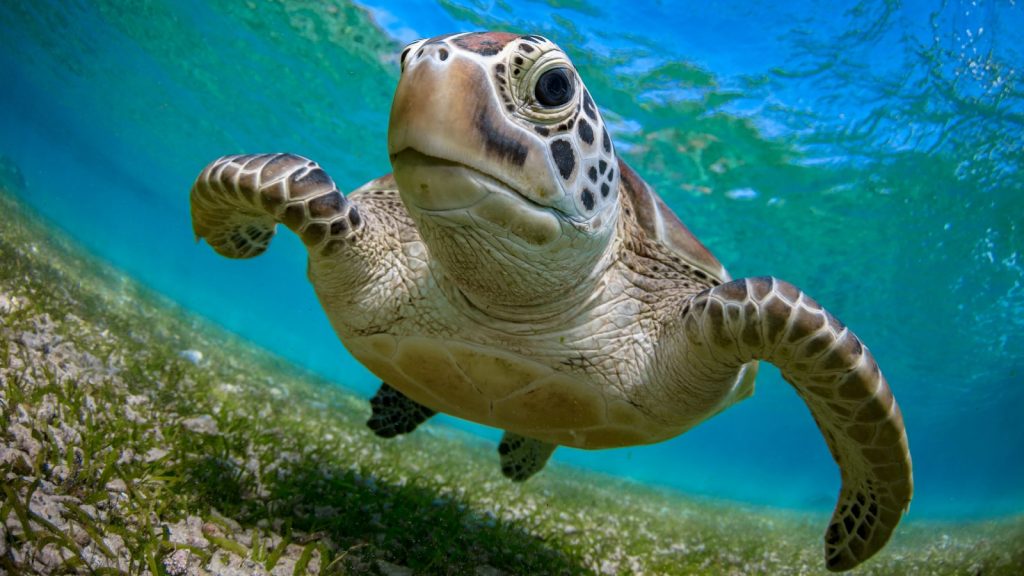
It may look unassuming, but seagrass plays a fundamental role in many ecosystems around the world. In honour of Seagrass Awareness Month 2024, we’re exploring how our marine friends – the dugongs and the sea turtles – help these plants to flourish.
What is seagrass?
Contrary to what the name would suggest, seagrass is more than just grass. It comprises about 60 species of flowering plants – the only flowering plants that can grow in marine environments. Seagrass is usually found around salty and shallow coastal areas, bays, and estuaries, and has a huge impact on the environment, despite covering less than 0.1% of the seafloor.
Why is seagrass important?
Thanks to its ability to photosynthesise, seagrass plays a vital role in not only marine ecosystems, but in preventing global warming. Like land plants, seagrass can capture carbon and create oxygen, helping to sustain both marine and terrestrial life. Amazingly, seagrass meadows can remove carbon from the atmosphere up to 35x faster than tropical rainforests, making them carbon-capture powerhouses!
Seagrass also provides shelter and stable homes for fish and shellfish – the plant’s roots prevent sand and other sediments from being washed away by tides. And to add to the list of seagrass’s benefits, it also offers a tasty meal for dugongs and turtles – two animals that have established a symbiotic relationship with the plant.
How dugongs and sea turtles are helping seagrass
Both dugongs and sea turtles have established symbiotic relationships with seagrass, helping each other – as well as other marine animals – to flourish in the marine ecosystem. Both animals gain vital sustenance from eating seagrass, while helping disperse the plant’s seeds over huge distances through their poop (up to 400 miles!).
But it’s not just the far-reaching dispersal of seeds that makes this relationship so helpful for the seagrass species. Scientists have discovered that seeds passed through the digestive system of dugongs and turtles also have a much faster rate of germination – taking weeks, rather than months.
It may seem counterintuitive, but even the grazing itself helps the seagrass to thrive, stimulating the growth of new shoots and leaves. The grazing process also removes the older blades, allowing more light to reach other parts of the plant for more efficient photosynthesis.
Seagrass Awareness Month – why conservation of seagrass, turtles, and dugongs is so important
This special relationship between dugongs, turtles and seagrass is just one example of the evolutionary complexity of nature, and how every animal has a vital role to play in its native ecosystem. Unfortunately, green sea turtles and dugongs are both highly threatened species, and are respectively categorised as endangered and vulnerable by IUCN.
I was recently very lucky to do some snorkelling with marine life, where I communicated with a green sea turtle. She explained to me that seagrass gives her species so much more than food – ‘we eat her and she grows stronger. We nourish her recovery. We do not take without being part of the life cycle’.
The experience left me with a new appreciation of seagrass and reminded me of the delicate balance required to sustain an ecosystem.
Sadly, it’s estimated that we lose an area of seagrass the size of two football pitches every hour, because of issues such as pollution and coastal development. That’s why it’s extremely important to raise awareness of the role seagrass plays, not only in the lives of turtles and dugongs, but for the health of the entire planet.
How you can help protect the world’s seagrass
Protect Seagrass is a fantastic organisation striving to protect seagrass meadows through community, research, and action. You can visit their website to donate, volunteer, or get involved in other opportunities across the UK.
You can also visit the Animal Thoughts Blog for more inspiration and information on animal communication.
Join our newsletter for more of Pea’s Posts and news
Pea Horsley is an international teacher, TEDx speaker and bestselling author of 3 books including ‘Heart to Heart’ and ‘The Animal Communicator’s Guide’, which have been translated into nine languages, online course Animal Communication Made Easy, and creator of the Conversations with Nature World Summit. Pea is the UK’s most highly regarded animal communicator and wild animal retreat facilitator. Join Pea’s membership, The Pride, and be part of a global community listening to a council of animals advising humanity and together forging real transformation.



